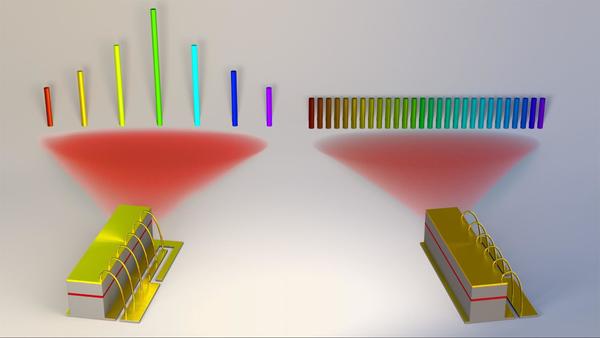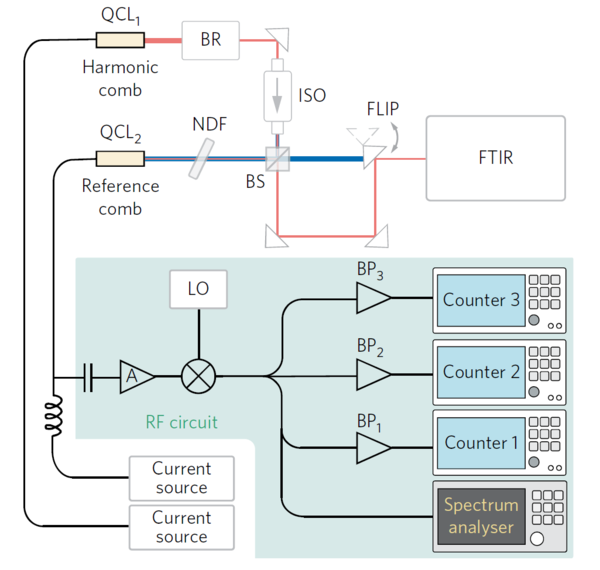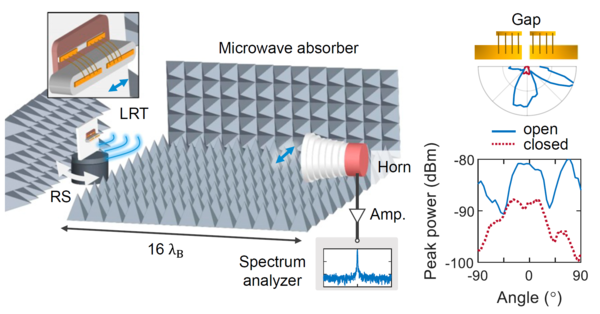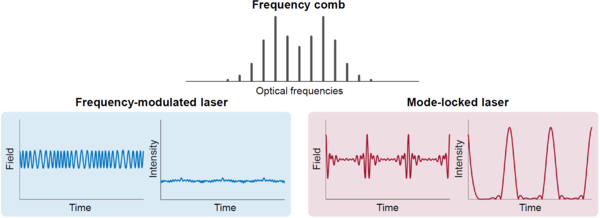Introduction
Frequency combs are widely-used, high-precision tools for measuring and detecting different frequencies — a.k.a. colors — of light. Unlike conventional lasers, which emit a single frequency, these lasers emit multiple frequencies in lockstep, evenly spaced to resemble the teeth of a comb. We study in particular quantum cascade laser frequency combs operating in a strategic region of the electromagnetic spectrum - the mid-infrared - which allows to detect molecular fingerprints of plenty of materials and gases. Our research ranges from fundamental laser physics, which aims at understanding new photonic and electronic properties of these frequency combs, to the engineering of a new class of devices that we call “laser radios”, which have an attractive potential for wireless terahertz communications and sensing.
Self-starting harmonic frequency combs
We are exploring the possibility of using an infrared frequency comb to generate elusive terahertz frequencies. These frequencies — which lie in the electromagnetic spectrum between radio waves and infrared light — have long promised to transform communications and sensing but are very challenging to source. By harnessing a recently discovered laser state, we have discovered an infrared frequency comb in a quantum cascade laser that offers a new way to generate terahertz frequencies. Dubbed a harmonic frequency comb, this new system produces a spectrum of teeth with spacing tens of times larger than traditional frequency combs. The large but precise spacing allows these modes of light to beat together to produce extremely pure terahertz tones.


For more information, visit: https://www.seas.harvard.edu/news/2017/10/bridging-terahertz-gap
Radiofrequency gratings in quantum cascade lasers
We have uncovered a new phenomenon of quantum cascade laser frequency combs, which could allow these devices to act as integrated transmitters or receivers that can efficiently encode information. This work represents a complete paradigm shift for the way a laser can be operated. This new phenomenon transforms a laser — a device operating at optical frequencies — into an advanced modulator at microwave frequencies, which has a technological significance for efficient use of bandwidth in communication systems. Inside the laser, the different frequencies of light beat together to generate microwave radiation. We discovered that light inside the cavity of the laser causes electrons to oscillate at microwave frequencies — which are within the communications spectrum. These oscillations can be externally modulated to encode information onto a carrier signal.


For more information, visit: https://www.seas.harvard.edu/news/2018/04/laser-frequency-combs-may-be-future-wi-fi and watch the following video:
Laser radio transmitter
We demonstrated a laser that can emit microwaves wirelessly, modulate them, and receive external radio frequency signals. The first thing the new device needed to transmit microwave signals was an antenna. So, we etched a gap into the top electrode of the device, creating a dipole antenna (like the rabbit ears on the top of an old TV). Next, we modulated the frequency comb to encode information on the microwave radiation created by the beating light of the comb. Then, using the antenna, the microwaves are radiated out from the device, containing the encoded information. The radio signal is received by a horn antenna, filtered and sent to a computer. We also demonstrated that the laser radio could receive signals. We were able to remote control the behavior of the laser using microwave signals from another device.


For more information, visit: https://www.seas.harvard.edu/news/2019/04/first-laser-radio-transmitter
Physics of frequency-modulated combs
We were able to reconstruct on a time scale of a trillionth of a second the waveform emitted by quantum cascade lasers, sources widely used in spectroscopy and sensing. We found that the lasers choose to emit light waves in a way that not only suppresses the intensity fluctuations —leading to a constant intensity in time — but also maximizes the power output. We discovered that a frequency-modulated laser can adjust parameters by itself, similar to a DJ turning knobs on a music synthesizer, to minimize fluctuations of the emitted intensity wave. Turning all these knobs in the right way is not an easy task. In producing a nearly-flat intensity waveform, the frequency-modulated laser has solved a complex optimization problem, performing just like an analog computer.


For more information, visit: https://www.seas.harvard.edu/news/2019/06/fundamental-physics-frequency-combs-sheds-light-natures-problem-solving-skills